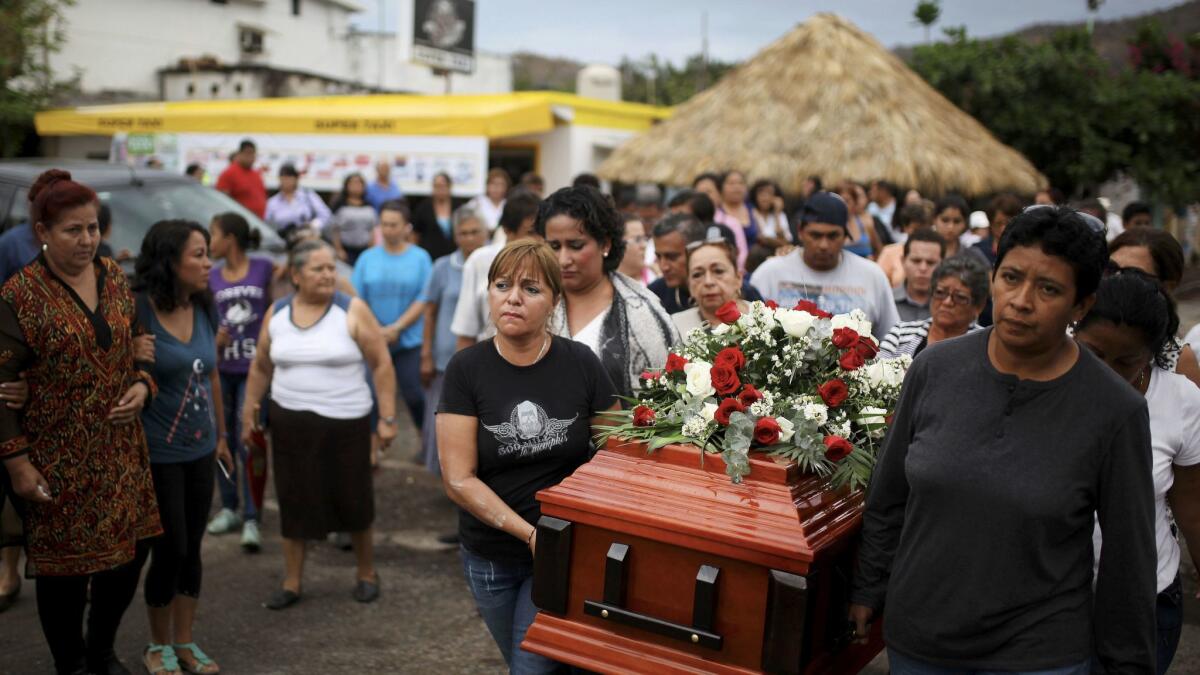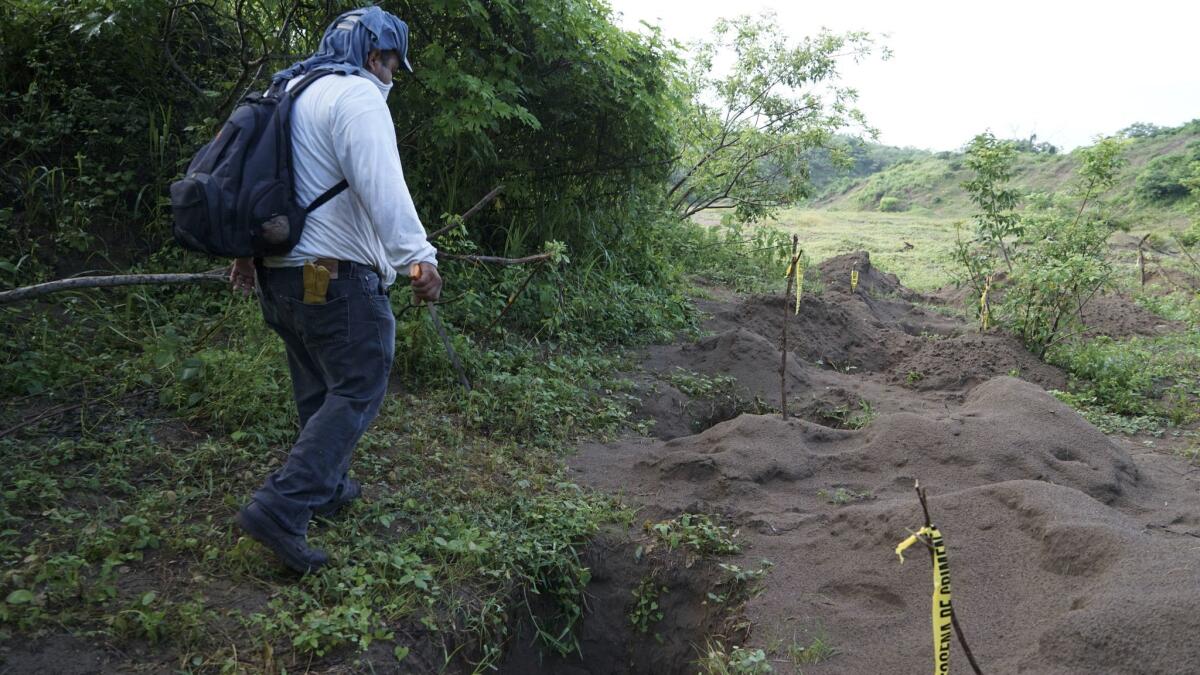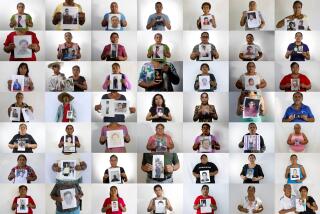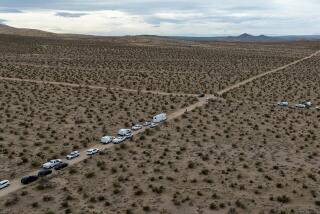A mother who dug in a Mexican mass grave to find the ‘disappeared’ finally learns her son’s fate

Pedro Huesca, an investigator for the Veracruz state district attorney’s office, was waylaid by armed men in 2013 and never seen again.
When she first saw the desolate stretch of coastal swamplands, Griselda Barradas said she felt sure that her harrowing search had finally ended.
“When I arrived, I had the feeling that here I would find my son,” recalled Barradas, whose son, Pedro Huesca, 30, disappeared almost four years ago.
Huesca, an investigator for the Veracruz state district attorney’s office, and his assistant were waylaid by armed men on April 15, 2013, in the city of Cardel. Neither was ever seen again.
But investigators using DNA evidence finally determined that Huesca’s body and that of his assistant, Gerardo Montiel Hernandez, were among the remains found in recent months in a series of clandestine graves outside the city of Veracruz, in an area known as Colinas de Santa Fe.
The two are the first positively identified victims from the mass gravesite, where volunteer diggers — mostly widows and mothers of the missing, including Barradas — have spearheaded an extraordinary effort that has thus far led to the discovery of the remains of more than 250 people in 125 separate graves, activists say.
The searchers began digging last summer after receiving a tip about the site, apparently from someone knowledgeable about the illicit activity. The tipster provided a rough map with crosses marking where people had been interred, often buried in black plastic trash bags.
The area was apparently used for years as a dumping ground for criminal gangs, including drug cartels like the Zetas, which control much of the illegal trafficking in Veracruz state. Relatives suspect that corrupt authorities in the state, working in league with criminal elements, were fully aware of the macabre traffic back and forth to Colinas de Santa Fe.

Last week, the mass grave made international headlines when the state district attorney, Jorge Winckler, told the Televisa network that 250 skulls had been unearthed in the sprawling field. He called for national and international aid to help identify the remains unearthed from what likely will end up being the largest mass grave found in Mexico.
“Veracruz is an enormous grave,” he said. Digging continues.
Mexico’s decade-long war on drugs has yielded tens of thousands of victims. Many are classified as desaparecido — disappeared, people who vanished without a trace.
Officially, Mexican officials acknowledge some 28,000 disappeared, some dating back to civil unrest in the 1970s. Activists say the number is likely higher and has swelled during the decade of the drug wars.
Veracruz is an enormous grave.
— Jorge Winckler, Veracruz state district attorney
The ranks of the vanished include many with no known link to criminal gangs. They may have been kidnapped for ransom, robbery or revenge, or caught in the wrong place at the wrong time, or were victims of mistaken identity.
Relatives of the disappeared, like Barradas, have long complained that Mexican authorities were not responsive. Most have endured maddening rounds of visits to police stations, morgues, hospitals and shelters seeking missing loved ones.
The official indifference, they say, reflects an insidious reality: Police and other law enforcement authorities have been implicated in illegal abductions, often in cahoots with gangs.
Facing institutional apathy, frustrated relatives across the country have taken up picks and shovels and started to dig into the earth in search of any clue to the fates of their kin. Searchers in recent years have found scores of clandestine burial grounds, from Mexico’s desert north to its subtropical south.
But nowhere has the volume of human remains disinterred matched that unearthed so far in the mosquito-infested field in Veracruz state. That attests to the intensity of the violence and depth of impunity in a coastal state that is along a major corridor of drugs and migrants headed to the United States. Gangs control the lucrative traffic.
Killers routinely remove all traces of ID on their victims, greatly complicating efforts to identify those found in secret graves.
Despite last week’s comments from Winckler, the Veracruz state district attorney, activists say the state and federal governments have been of little help in the complex effort of identifying victims.
“The new governor hasn’t even approached us,” said Lucia Diaz, coordinator and co-founder of the Solecito Collective, the citizens group that has been digging at the Colinas de Santa Fe site. “We know that the authorities have no interest in the situation of our disappeared relatives. They do nothing.”

Winckler is part of the new administration of Veracruz Gov. Miguel Angel Yunes Linares, who took office in December under the banner of an opposition party coalition. He succeeded Javier Duarte, a former stalwart of Mexico’s ruling party who has become a symbol of corrupt governance in the country — a fugitive wanted on charges of money laundering and links to organized crime.
In the Televisa interview, Winckler blamed the previous administration’s theft of public money for a lack of investigative resources.
But activists argue that the current state administration has the means to accelerate what has become a mass murder inquiry.
“It’s very easy to blame previous governments and wash one’s hands,” said Diaz, whose son, Luis Guillermo Lagunes Diaz, a popular disc jockey and events promoter in Veracruz, disappeared on June 28, 2013, apparently abducted from his home. He was 29.
Authorities have collected some DNA samples from grieving relatives but so far only Huesca and Montiel have been identified.
Huesca, who had a pair of master’s degrees and a passion for law enforcement, sought to use his skill and knowledge to further the cause of justice in Mexico, his mother said.
“My son was a very honest person,” said Barradas, 56, speaking in a telephone interview. “He had a lot of dreams, like so many young people who were disappeared and saw their dreams smashed.”
On April 15, 2013, Barradas said, she heard gun shots in the morning in the city of Cardel. Later, she said, she went out to do some shopping and spotted her son’s official SUV. His wife was by the car, crying. Police told the two that an armed group had fired shots, waylaid the investigator’s vehicle, and taken him and his assistant away.
Police escorted the two stunned women to the headquarters of the navy, which is heavily involved in anti-drug efforts. Her son, Barradas noted, had often worked in conjunction with naval personnel in an effort called Veracruz Seguro, or Safe Veracruz. But no one knew anything of her son’s fate.

Later, she said, she would learn through the official investigation that the police had helped facilitate her son’s kidnapping in concert with the gunmen.
“Imagine, the same police who turned my son over were at the scene of the crime and took us to notify authorities!” recalled Barradas, still finding the scenario hard to believe.
Two men have been arrested in connection with her son’s disappearance, but Barradas says she considers them lower-level operatives, not the bosses who ordered his killing. She believes her son’s slaying was linked to his investigation of criminal activities in Veracruz.
Barradas is among the many relatives of the disappeared who have joined the volunteer searchers from the Solecito Collective combing the fenced-off fields of Colinas de Santa Fe on the outskirts of Veracruz city, only a few hundred yards from a housing complex. Something about the forbidding site, she said, led her to believe that it would turn out to be her son’s resting place. She also provided DNA samples.
Barradas, like others, said she has found some sense of comfort in the physical effort of digging in search of what is left of some of the anonymous multitudes lost in Mexico’s wave of violence.
“Yes,” she said proudly, “I pick up a shovel myself and I proceed to search in the ground.”
On Jan. 17, Barradas said, she received a telephone call from the district attorney’s office bearing unexpected news: The remains of her son had been identified.
“I thank God this finally ended the torment of not knowing what happened to my son,” said Barradas. “The parents who look for their sons, we have no peace, we have no relief, we live day and night in anguish. It is a pain that one cannot explain.”
To read the article in Spanish, click here
Sanchez is a reporter in the Times’ Mexico City bureau.
ALSO
He said, ‘I’m on my way, Mama.’ Then, like thousands of others in Mexico, he vanished
He defended the sacred lands of Mexico’s Tarahumara people. Then a gunman cut him down
Under pressure, Mexican-owned Cemex says it won’t help build Trump’s border wall
More to Read
Start your day right
Sign up for Essential California for news, features and recommendations from the L.A. Times and beyond in your inbox six days a week.
You may occasionally receive promotional content from the Los Angeles Times.






